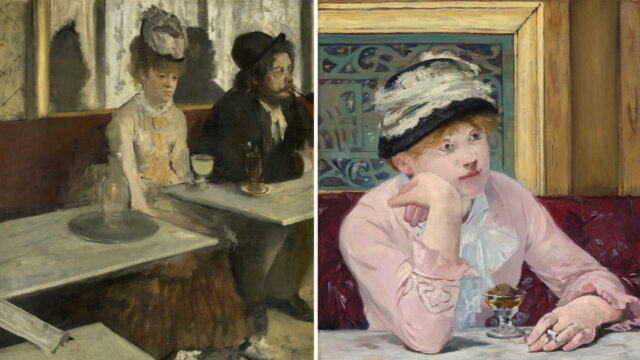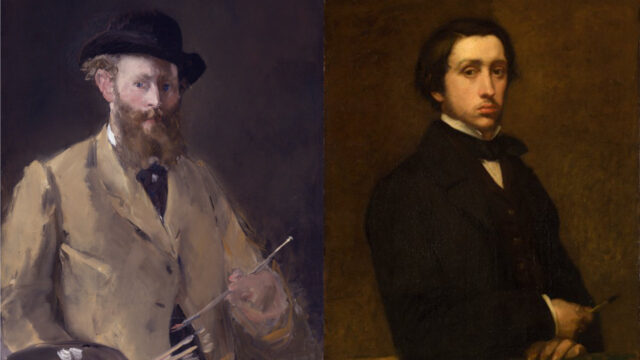
Edgar Degas, In a Café (The Absinthe Drinker), oil on canvas, 1875–76 (Musée d’Orsay, Paris); Edouard Manet, Plum Brandy, oil on canvas, ca. 1877 (National Gallery of Art, Washington, DC, collection of Mr. and Mrs. Paul Mellon)
MANET / DEGAS
Metropolitan Museum of Art, Met Fifth Ave.
1000 Fifth Ave. at 82nd St.
Through January 7, $30 (NY, NJ, CT residents pay-what-you-wish)
212-535-7710
www.metmuseum.org
In 2003, MoMA hosted the revelatory exhibition “Matisse Picasso,” a dramatic exploration of the documented, nearly half-century rivalry between the French Henri Matisse and the Spanish Pablo Picasso.
The Met is now taking a similar approach with “Manet/Degas,” a deep dive into the personal and professional relationship between French artists Édouard Manet (1832–83) and Edgar Degas (1834–1917), albeit with far less direct evidence. “Each was incredibly ambitious, and their sustained, thoughtful, and at times competitive observation of one another and their contemporaries would become vital to their enterprise,” Met director and CEO Max Hollein says in the below video. However, wall text points out, “Attempts to assess the relationship between Manet and Degas are complicated by the sparse record of their exchanges,” and the narrator on the audioguide explains, “Manet and Degas would continue to push each other to take the risks that would define their careers. But they left little evidence of their relationship in their papers. For example, though Degas speaks of Manet in his many letters to others, none of his letters is addressed to Manet. And for his part, Manet left just a few letters to Degas.”
The show opens with Manet’s Portrait of the Artist (Manet with a Palette) and Degas’s Portrait of the Artist next to each other, setting up the side-by-side nature of the exhibit, which comprises more than 160 paintings and works on paper. The men, born two years apart, met in the Louvre in 1861–62 and both became friends with artist Berthe Morisot, who later married Manet’s younger brother, painter Eugène Manet. They both copied Diego Velázquez’s depiction of Infanta Margarita. Before they met, they had each made a self-portrait in the style of Filippino Lippi. Manet’s The Madonna of the Rabbit, after Titian hangs next to Degas’s The Crucifixion, after Mantegna. At the 1865 Salon, Manet’s Olympia created a furor, as opposed to Degas’s relatively unrecognized Scene of War in the Middle Ages; the paintings hang nearby each other at the Met.
In 1868–69, Degas made a series of drawings of Manet in addition to a painting of Manet relaxing on a couch, looking at Degas as Manet’s wife, Suzanne Leenhoff, played the piano. He gave the canvas to Manet, who quickly slashed off the right side so his wife’s face and the piano were no longer visible. Degas ended up keeping the work and hanging it on his wall, eventually adding a blank strip that perhaps signaled that he was going to restore the missing section, but he never did. Manet never drew or painted Degas, but he did paint Suzanne at the piano, perhaps as a response to Degas’s work. While Degas collected paintings and drawings by Manet, Manet did not seem to return the favor. Degas helped organize the first Impressionist exhibition, in 1874, while Manet decided not to participate.

Edouard Manet, Portrait of the Artist (Manet with a Palette), oil on canvas, ca. 1878–79 (private collection); Edgar Degas, Portrait of the Artist, oil on paper mounted on canvas, 1855 (Musée d’Orsay, Paris)
Other telling pairings at the Met include Manet’s Standing Man, after del Sarto and Degas’s Study of a Draped Figure, Manet’s Lorenzo Pagans and Auguste De Gas and Degas’s Music Lesson, Manet’s The Dead Toreador and Degas’s Scene from the Steeplechase: The Fallen Jockey, Manet’s The Races in the Bois de Boulogne (in which the figure at the lower right might be Degas) and Degas’s The False Start, Manet’s Plum Brandy and Degas’s In a Café (The Absinthe Drinker) (which feature the same model, actress Ellen Andrée), Manet’s On the Beach, Boulogne-sur-Mer and Marine and Degas’s Beach Scene and Fishing Boat at the Entrance to the Port of Dives, Manet’s Monsieur and Madame Auguste Manet and Degas’s Hilaire Degas, and Manet’s Woman with a Tub and Nude Arranging Her Hair and Degas’s Woman Bathing in a Shallow Tub and Nude Arranging Her Hair.
The show is divided into such sections as “An Enigmatic Relationship,” “Artistic Origins: Study, Copy, Create,” “Family Origins and Tensions,” “Challenging Genres at the Salon,” “The Morisot Circle,” and “At the Racecourse,” tracing the many intersections of Manet’s and Degas’s personal and professional lives, which continued after Manet’s death in 1883 at the age of fifty-one, as Degas, who died in 1917 at eighty-three, purchased more of Manet’s work, highlighted by his unsuccessful attempt to bring together all fragments of Manet’s masterpiece The Execution of Maximilian.
But the Met, in collaboration with the Musées d’Orsay et de l’Orangerie, has done a marvelous job of bringing together the work of the these two giants, friends and rivals whose lives overlapped in captivating ways.
[Mark Rifkin is a Brooklyn-born, Manhattan-based writer and editor; you can follow him on Substack here.]